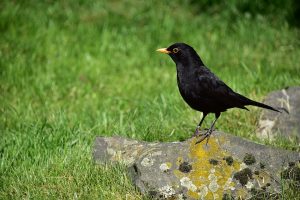It’s an age-old problem that many gardeners face. Trying to achieve a beautiful lawn is difficult when the minute your back is turned, wild birds are dining out on your freshly sown seed.
Knowing how to stop birds eating grass seed is one thing, but knowing how to do it safely, without harming or scaring our feathered-friends away for good, is another.
There are multiple methods worth attempting to keep the birds away, some involve buying specialist seed and others rely on scare tactics. The initial planting of the seed an inch below ground gives them the greatest protection, the grass won’t appear until they have begun to germinate, by which time the birds will have lost interest.

Table of Contents
Do Birds Eat Grass Seed?
They most certainly do, and if a flock arrive with empty bellies, they just may stay until they have eaten it all.
Seeds are a vital part of a birds diet as they are full of nutrients, vitamins, and minerals.
Ground feeding birds, in particular, enjoy grass seeds as they are tasty and easy to swallow. Because finches and sparrows have soft beaks, they can easily pick up the small seeds and gain great nourishment from it.
Birds tend to prefer seeds with a thinner shell but will eat any variety if they’re hungry enough.
Methods of keeping the birds off your grass seed
Specialist seeds
These come in 2 varieties;
- Coated seeds have a horrid tasting coating that is harmless to the birds. Although this discourages their interest, it will take longer for grass to grow.
- Absorption seeds are designed to promote exceptionally fast growth. They absorb so much moisture that they grow 10X faster than regular seeds. Although they don’t deter the birds, germination occurs rapidly, leaving them little chance to steal the seeds. Their downside? They are more expensive.
Mulch
If you’re seeding a large area and it isn’t possible to dig all of the seeds in, consider covering them instead. Rake the area first to allow them to settle as deep as possible. Straw is the perfect mulch as it allows light and moisture in so that the seeds can still germinate. A single bale of straw covers about 1000 square feet and you should only need 75% coverage.
Sadly, if you live in a particularly windy climate, straw probably won’t help.
Burlap
This is another method that employs the covering technique. Burlap/hessian is a natural, woven fibre that lets light and moisture through. It offers total protection of an area as it can be staked down and remain in situ until germination occurs.
Mylar Tape
A reflective, shiny tape that rustles and frightens birds when allowed to blow freely in the wind.
Attach it to posts, around 6 feet apart, surrounding the newly-seeded area and watch the birds lose interest. Similarly, tying aluminium trays or old CDs will work. The combination of the noise and the shiny reflections will scare them away.
Noise
We have all seen birds flee at the sound of clapping or loud chatter, they don’t like noise. There are devices available to play sounds around the garden, but wind chimes look and sound better and have the same effect.
Distraction Tactics
If all else fails, offer the birds a banquet in an area as far away from the seeded lawn as possible. Fill feeders with their favourite treats, and ensure the table is covered in mealworms, fruits, and suet delights. Hopefully, they will be far too busy feasting to notice meagre seeds!
Finally
To grow the perfect luscious lawn you will need 3 things; warmth, moisture, and light. (4 things if you include grass seed)!
What you don’t need is birds helping themselves to the seed before it has the chance to grow.
I hope this guide has given you an idea of how to stop birds eating grass seed without harming or losing these beautiful creatures and their wonderful song from your garden.
